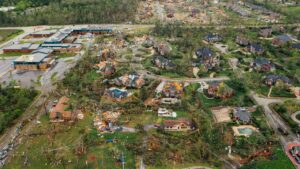Tips for Dealing with Damage to Your Home After a Spring Storm
As the warmth of spring is upon us, so is the unpredictability of the weather. Spring storms, with their gusty winds and pounding rains, (or worse, tornadoes and flooding) can wreak havoc on our homes, leaving behind a trail of damage and destruction. While we can’t control the weather, we can certainly take proactive steps to mitigate the impact of these storms on our homes. Let’s explore some practical tips for dealing with damage to your home after a spring storm, helping you navigate the aftermath with confidence.

Assessing the Damage
The first step in dealing with damage to your home after a spring storm is to conduct a thorough assessment of the affected areas. Inspect both the interior and exterior of your home for any signs of damage, including:
- Roof: Check for missing or damaged shingles, leaks and signs of water damage in the attic.
- Windows and Doors: Look for cracks, broken glass or gaps that may have been caused by high winds.
- Siding: Inspect your siding for dents, cracks or loose panels.
- Gutters and Downspouts: Clear any debris from your gutters and check for damage that could impede proper drainage.
- Trees and Landscaping: Assess any damage to trees or landscaping around your home, including fallen branches or uprooted trees that may pose a threat to your property.
Safety First
Before attempting any repairs, prioritize safety. If you suspect structural damage to your home, such as a compromised roof or foundation, it’s best to evacuate and seek professional assistance. Additionally, be cautious of any downed power lines or submerged electrical outlets, as these can pose serious hazards.
Documenting the Damage
Once you’ve assessed the damage, document everything thoroughly. Take photographs or videos of the affected areas, making sure to capture any visible damage from multiple angles. This documentation will be invaluable when filing insurance claims and working with contractors to repair the damage.
Temporary Repairs
 In some cases, you may need to make temporary repairs to prevent further damage to your home. This could include tarping a damaged roof to prevent water intrusion or boarding up broken windows to secure your property. While these repairs may be temporary, they can help protect your home until more permanent repairs can be made.
In some cases, you may need to make temporary repairs to prevent further damage to your home. This could include tarping a damaged roof to prevent water intrusion or boarding up broken windows to secure your property. While these repairs may be temporary, they can help protect your home until more permanent repairs can be made.
Contact Your Insurance Company
After documenting the damage, contact your insurance company to file a claim. Be prepared to provide them with detailed information about the extent of the damage, including any documentation you’ve gathered. Your insurance company will guide you through the claims process and help you understand what is covered under your policy.
Hiring Professional Help
Depending on the extent of the damage, you may need to hire professional contractors to make repairs to your home. When choosing a contractor, be sure to do your research and select reputable, licensed professionals with experience in storm damage repair. Obtain multiple quotes and ask for references before making a decision.
Check out our list of preferred vendors we trust for any of your repair needs.
Preventing Future Damage
Once repairs have been made, take steps to prevent future damage to your home. This could include reinforcing your roof, installing storm shutters on windows or trimming trees and landscaping to reduce the risk of falling branches. Additionally, consider investing in a generator or backup power source to keep essential systems running during power outages.
Dealing with damage to your home after a spring storm can be a stressful and overwhelming experience, but with the right approach, you can navigate the aftermath successfully. By assessing the damage, prioritizing safety, documenting everything and seeking professional assistance when needed, you can restore your home to its former glory and prepare for whatever the next spring storm may bring. If you should have more specific questions or referral needs, don’t hesitate to reach out to our Dani Beyer Real Estate Team for Kansas City resources!
Dani Beyer, a Kansas City native, began her career in real estate in 2004 after working in the tech industry. Since then, she's helped thousands of families turn their dreams into keys! Dani is now the CEO and Lead Listing Specialist of 'Dani Beyer Real Estate' brokered with Keller Williams KC North. She specializes in selling luxury homes in the Kansas City Northland.

